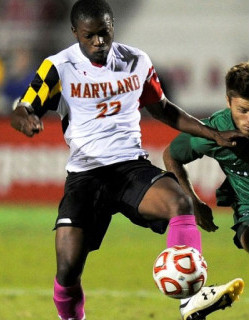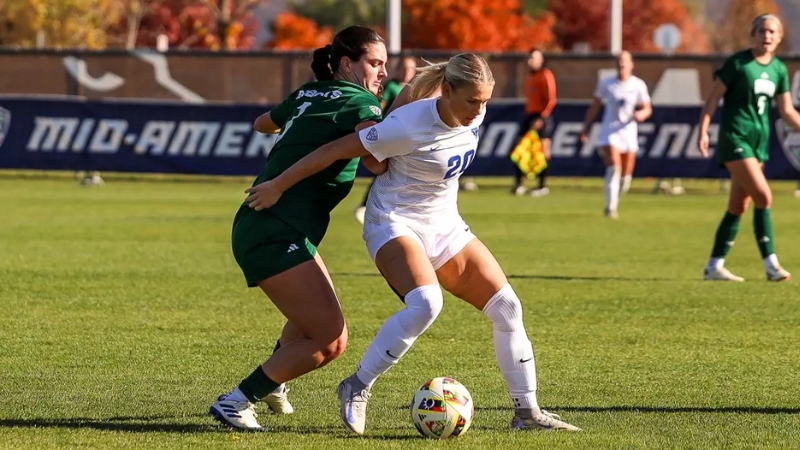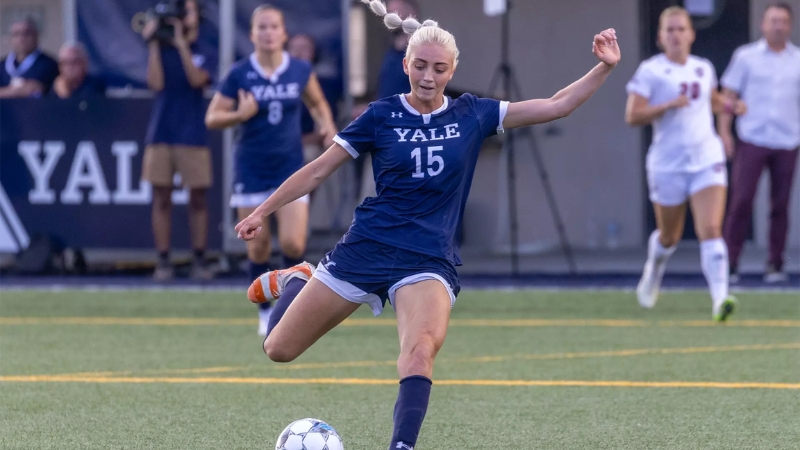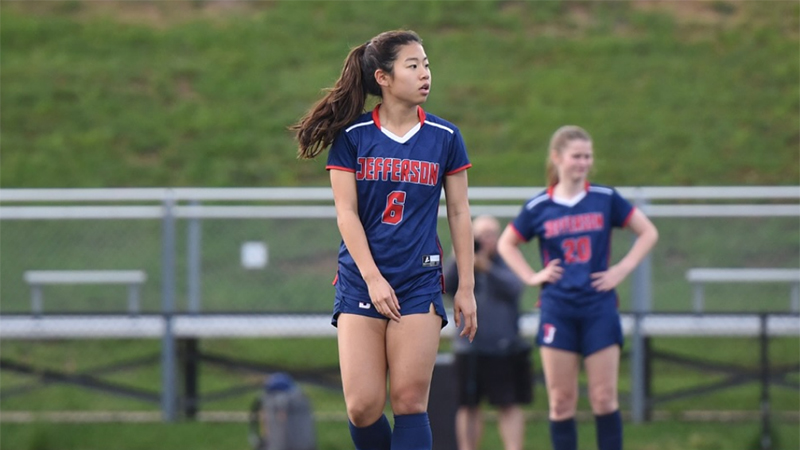 Suliaman Dainkeh
Suliaman DainkehHS/DA split still a work in progress

Kyler White was stuck.
The talented young keeper had played for Philadelphia Union Development Academy affiliate FC Delco for years, even moonlighting with the Union’s on-again, off-again academy team at the time in fall exhibitions against other academy sides. He started in Delco’s club setup and then moved through the system, through the pre-academy, then as a cog on the U16 side and then as a starting U18 keeper last year.
 Suliaman Dainkeh
Suliaman DainkehBut White felt conflicted. In 2012, the USSF split high school soccer and the academy system down the middle, requiring high school-age boys players to choose one or the other barring a waiver. For a large portion of the country, that emptied high school soccer rosters of some of their best players as scores chose the brighter lights and stiff competition offered by the academy. With only one year left of high school, White was now questioning his decision.
“You only have four years of high school,” White said. “Why not be able to play? I think that should be a statement. I feel like U.S. Soccer should take that into consideration. You only have four years to play high school, why not let us play? I’m not angry at the academy because I understand the way they’re going with it now, how soccer’s becoming bigger in America, but you do only have four years of high school. And that factored into my decision.”
After speaking with as many coaches on both sides as he could, White decided to leave his starting post with Delco (now Continental FC) and migrated to high school soccer for the first time. White finished out his high school career this fall with Haddon Township High School, which he says he doesn’t regret. He admits the scouts at his games thinned out - in fact, he said he’s never seen a college scout at a high school soccer game - and the level of play is perhaps more uneven in spots, but he wanted the option to choose.
“Most people from my area don’t understand the whole academy thing,” White said. “They look at it like, why can you only play that and not play high school? Kids I used to play academy with, some of them would complain about not being able to play high school because they realize it’s really fun. Some of them just wanted to play academy, but I think it’s pretty conflicting.”
In its year-plus of implementation, the Development Academy’s decision to force players to choose between its ranks and high school has received mixed reviews. Last September, Dave Verso, a father of two former academy players, lobbed criticism at the academy via the L.A. Times by saying the environment is “ill-suited” to help players solve problems. In late 2012, the New York Times ran an in-depth profile of Montclair High School’s Oliver Murphy, who labored over his decision to choose academy over high school.
A sizable chunk of the nation’s players and coaches voiced concern that the academy’s attempt at consolidating its ranks felt like an unnecessary power grab. But from the academy’s perspective, it was merely good sense that led them to the decision. By better controlling the environment available to players, U.S. Soccer could better control the developmental atmosphere on a macro level and position players better for the next level.
And further, the decision didn’t limit a player’s ability to play high school. It just forced him to choose.
“I think it’s been a very important platform, especially for a club like ours, to get meaningful games,” said Colorado Rapids senior director of youth development Brian Crookham. “That’s been the biggest benefit to us, is it’s a ready-made source of meaningful games. Setting a standard for trying to get clubs with similar mentalities together has been a big positive for us. It’s given us a big platform to compete in matches a lot closer to what we would’ve wanted it to look like than maybe what we would’ve gotten in maybe a traditional US Youth or US Club format.”
Tim Carter is the director of boys soccer and head U18 coach for Minnesota-based Development Academy side Shattuck St. Mary’s. The club is unique in that it straddles the ocean between boarding school and development academy, which has made it one of the most talent-rich youth soccer programs in the nation. He’s spent decades around the game in the U.S., and he helped guide Shattuck to the title game of the U18 playoffs last summer. Some of Carter’s previous experience with the Olympic Development Program led him to believe that players who left for high school didn’t come back as sharp as when they left.
“Kids would come out of the national teams and they’d go back to their high school, and they’d come back in around Thanksgiving and join their national team, and we would see the regression from the players,” Carter said. “Going back to the high school season and then coming back, there was a regression. Things high school coaches are saying is we buy it for the pros, but are you taking too much of the mass? They might have a point there. But the reality is you had to create another functioning environment, and it required the number of clubs that are out there that are willing to do it this way.”
Not everyone at the academy level hopped on board with the decision. One of the most stark examples was provided last fall by Steve Nichols.
Nichols has been coaching soccer for more than 20 years, a good chunk of which was at the head of Baltimore Bays Chelsea, perennially one of the best academies in the nation. He took the club to the national finals in five of his six years there, and his roster of former players stretching back to his early days includes senior national team veterans like Kyle Beckerman and Oguchi Onyewu. Dissatisfied with the way the academy was trending, Nichols opted to leave last year and took nearly all of his players and coaches with him. He formed his own club, Baltimore Celtic, and continued coaching at McDonogh School, one of the nation’s best high school programs.
The Mid-Atlantic region is unique in the sense that the general state of high school soccer is arguably more robust than the academy. Programs like Nichols’ McDonogh, Good Counsel, St. Paul’s, Gilman and Loyola make up the backbone of an area that pours resources into the high school game like few others. It’s one of the few areas of the country where players chose high school over the academy in not insignificant numbers when the split came down.
The way Nichols sees it, that’s part of the country’s vast, unique soccer tapestry that requires greater leeway at the local levels. So he left.
He says his final “wake-up call” came when U18 National Team member Suliaman Dainkeh opted to leave the D.C. United academy his senior year in 2012 to play high school soccer instead. Dainkeh is now a starting defender at Maryland, and he isn’t the only high-profile player to choose high school. Cristian Roldan, last year’s National Gatorade Player of the Year, chose his local El Rancho High School over Southern California’s glut of talented academies. Roldan just wrapped up his freshman year at Washington and established himself as one of the most exciting young players in the country.
“I’m just trying to get to the same end using a different means,” Nichols said. “The academy doesn’t work in our region. Kevin Smith (from Dallas, Texas-area academy club Solar Chelsea) is one of my best friends. I think he’d love to go back to the old way too when we were all doing it together in USYSA. But he’s in a region that has FC Dallas, Dallas Texans, Sporting Kansas City, Colorado Rapids. He has like five MLS teams and some great other teams.
“For us, in our region, it wasn’t worthwhile. We played a 28-game schedule last year, and besides DC United and PDA, we didn’t have any special games at all. So you play a 28-game schedule and you play four really good games? That’s not how you get better.”
Further, Nichols was frustrated by what he saw as too much oversight on experienced coaches who didn’t need it.
“Carlos Somoano won a national championship with UNC-Chapel Hill two years ago,” Nichols said. “He was at CASL for 10 years. So he comes out to coach a game and U.S. Soccer tells him they want him to play a 4-3-3. Carlos is playing a 3-5-2. They're going to tell Carlos Somoano what system to play and how to play? Little things like that.
“You've got guys coming and grading your training sessions and giving you grades on training and other things, and if Tab Ramos is coming to do it, or Bob Bradley or Jurgen Klinsmann, I get that. But the guys that are grading you and telling you how to do things really have never been that successful and are yes-men that have worked their way up the system."
For White and others like him, the decision lacks the finality of the black and white. Few question that the Development Academy is slowly raising the level of youth play in the U.S., and its national events have largely been well-oiled despite the fact that the academy is entering just its seventh year in existence. But questions linger about the value of high school soccer and its place in the game’s firmament in this country. Whether it’s the social side of things or simply the ability of each corner of a vast nation to be able to tailor best practices to its own unique circumstances, the debate ambles along.
White bears no ill-will toward U.S. Soccer but understands the inherent challenges of being scouted and playing at the next level through high school and smaller club leagues, which some players may prefer. As White found for himself, there aren’t any easy answers as the stakes continue to rise.
“I think it’s a high percentage that want to (play both academy and high school),” White said. “I wish I could do both, 100 percent. I can guarantee you most players that do academy now wish they can play both. Playing high school is a lot more fun than when I was playing academy. I think that’s maybe the social aspect. It has its pros and cons, like anything does.”
Headlines
- Recruiting Roundup: June 9-15
- 2025 Women's Division I Transfer Tracker
- How Do I Get Scouted by TopDrawerSoccer?
-
2025 Women's MAC Breakout Candidates

-
Player Rankings Spotlight: 2025 Girls

-
2025 Women's Ivy League Breakout C (...)

-
MLS NEXT Cup: Under-15 Players to Watch

-
2025 Women's Horizon Breakout Candidates

- IMG Academy Player Rankings: Boys 2026
- U15, U16 GNT Rosters Named for Euro Trip



